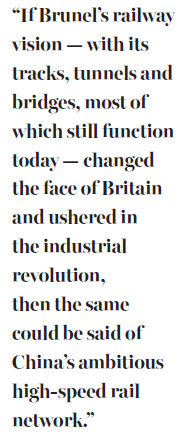Victorian-era hero helped spark Britain's industrial revolution, and now China is advancing in the same vein
Isambard Kingdom Brunel; it's a name that rolls off the tongue. He also happens to be one of my personal heroes, along with Admiral Lord Nelson and the Duke of Wellington.
But it's Brunel we're addressing today. I always think his parents, a French emigre engineer and an English woman, must have had a serious sense of humor when it came to naming their firstborn in 1802.
Brunel was a man with massive vision that, combined with the breathtaking arrogance of the era he lived in, means Britain is full of the tunnels, bridges and railway lines that sprang from his imagination. He was a nationalist who firmly believed in the word "great" in the country's name, Great Britain.

When I write of his arrogance, and his nationalism, it's not in a derogatory way. Victorians were imbued with a self-confidence that saw them build an empire "on which the sun never set" and constructed engineering marvels that have stood the test of time.
I'm thinking of the Clifton Suspension Bridge over the River Avon, which links England and Wales, and the Royal Albert Bridge over the River Tamar at Saltash, which links Cornwall with the rest of the world (an in-joke; my grandmother was Cornish).
But it was railways that stamped Brunel's name on the country's consciousness. He came up with the Great Western Railway, designed to link London, Bristol and later the southwestern city of Exeter. But he didn't stop there.
The United States was just opening up, and Brunel, with his usual broader approach, said travelers should be able to buy a ticket in Paddington Station, west London, bound for New York.
And so the SS Great Western was born, at its launch in 1838 the longest ship in the world, powered by steam and sail. It made 64 crossings of the Atlantic and led to the construction of her sister ship, the SS Great Britain, made entirely of metal and driven by a screw rather than paddle wheels. Fully restored, she is now preserved in her dry dock in her homeport of Bristol.
So what's this got to do with China? Well, put simply, I think the colossal intellect and engineering genius that was Brunel would have heartily approved of modern China's approach to infrastructure. Heck, he would have probably been bidding for the contracts.

I've written before how my first view of Shenzhen from the border post in Hong Kong in the late 1980s was a couple of apartment blocks standing forlornly in a landscape of rice paddies, with the only human in sight a farmer, dressed in a sun hat, singlet and shorts, who was herding thousands of snow-white ducks and geese.
It's changed a bit and now represents one of the parallels I draw between modern China and Brunel's 19th-century vision of Britain. Both share a dramatic vision of what the future should be, and the best way to go about it.
The construction of the glittering high-tech city of Shenzhen in little under 30 years is a case in point, but one project I think Brunel would have heartily approved of is China's high-speed rail network.
If Brunel's railway vision - with its tracks, tunnels and bridges, most of which still function today - changed the face of Britain and ushered in the industrial revolution, then the same could be said of China's ambitious high-speed rail network.
Simply put, in early 2007 there wasn't one. Now, 28 of China's 33 provinces and regions are served by 19,000 kilometers of high-speed tracks, with 30,000 km planned by 2020. In 2007, daily passenger numbers were 237,000, which by 2014 had risen to 2.49 million.
A 2,298-km journey from Beijing to Guangzhou in the south takes eight hours. You work it out.
Pictures of Wuhan's new railway terminus, with its soaring glass roof, have exact parallels with London's Paddington, a bit grimy now (steam does that to glass) but blessed with the same dramatic curved roof of glass and iron when it was built by - you've guessed it - Isambard Kingdom Brunel.
As a reminder, there's a larger-than-life statue of the great man eyeing passengers as they pour off the trains onto one of the main platforms.
So please, can China's best railway brains come to the home of the railway and build us a high-speed rail link from north to south?
The author is managing editor of China Daily European Weekly, based in London.
Contact the writer at chris@mail.chinadailyuk.com

I’ve lived in China for quite a considerable time including my graduate school years, travelled and worked in a few cities and still choose my destination taking into consideration the density of smog or PM2.5 particulate matter in the region.